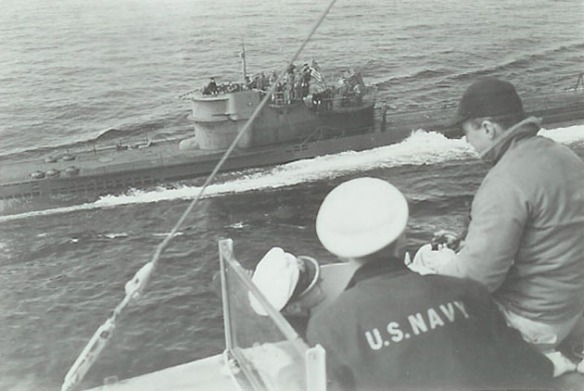
U-234 surrenders to USS Sutton, 1945.
Germany also commissioned a number of other important types of U-boat during World War II. Among the most important were the Type X minelayers and the Type XIV supply boats. Both types operated as resuppliers for the operational boats during the Battle of the Atlantic, providing fuel, provisions, medical supplies, reload torpedoes, and even medical care and replacement crew members. Consequently they became prime targets for Allied antisubmarine forces, and few survived.
The Type X was originally designed specifically to accommodate the newly developed Schachtmine A (SMA) moored naval mine. The initial design provided dry storage for the mines, which needed their detonators to be individually adjusted before launch; this submarine was projected to have displaced up to 2,500 tons. A further variant, the Type XA was projected, which would have supplemented the main mine chamber with extra mine shafts in the saddle tanks. Neither type entered production.[2]
A total of eight Type XB boats were produced, which replaced the mine chamber of the projected Type XA with six vertical wet storage shafts in the forward section of the hull. Up to 18 mines could be carried in these shafts, with an additional 48 mines in a series of 12 shafts set into the saddle tanks on each side. They only had two torpedo tubes, both at the stern. When used as cargo-carrying submarines they carried freight containers in the mine shafts (or had the freight containers welded on top of the lateral shafts, preventing their use for mines).
The first Type XB was launched in May 1941. At 2,710 tons submerged and fully loaded, they were the largest German U-boats ever built, and they had to sacrifice diving speed and agility.
Six of the eight boats built were sunk during the war (five with all hands) but two survived the war. One survivor was U-234, which surrendered to US Navy ships on 14 May 1945 while en route for Japan with a cargo that included 560 kg uranium oxide, two Me 262 jet fighters, and 10 jet engines.
The other type XB to survive was U-219 which reached Djakarta in December 1944 with a cargo including dismantled V-2 rockets for Japan. Following Germany’s surrender, U-219 was seized by the Japanese at Batavia on 8 May 1945 and on 15 July 1945 was placed into service with the Imperial Japanese Navy as I-505.